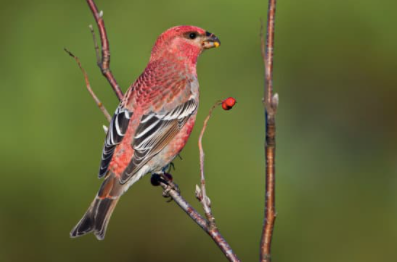Offer
Provide additional details about the offer you're running.
Provide additional details about the offer you're running.
Provide additional details about the offer you're running.

One of the largest members of the finch family, the wonderful plumage of the male pine grosbeak is a welcome sight to any winter scene. A resident of the north, these birds have very irruptive behaviour patterns in the winter months as they forage for suitable food sources, often bringing them into our neck of the woods.
The pine grosbeak is also notably tame; often allowing observers to get obscenely close, but this bird can also can sit motionless and allow potential on-lookers to easily pass them by. Basing much of their movements on the production of small fruits such as mountain ash, these birds follow their stomachs and can be found in large numbers where forage is substantial.
This being said, this year’s finch forecast is assuming many of these birds should remain in their northern range due to good mountain-ash berry crops in the north, but some in poor areas are expected to head to southern Ontario where mountain-ash berries and ornamental crab-apples are aplenty.
Traditionally, these birds are found high in the spruce and fir forests of the northern portion of North America. Their year-round range spreads from Alaska to Newfoundland, covering much of British Columbia and the northern portions of Alberta, Saskatchewan, Manitoba, Ontario, Quebec and a few Canadian Maritime Provinces. During the winter, these birds will head wherever the forage is best, heading south to the northern United States and here in the southern portion of Ontario.

During the winter months, they can be found almost anywhere that holds suitable food sources which often includes highly-concentrated urban areas.
The males are tough to miss, unless of course they are holding still as you pass them by. They sport a pink-red head, breast, back and rump with darker coloured wing and tail feathers. With a close enough look, the males eyes have the appearance of being dressed up with a touch of mascara, adding to their already stunning appearance.
The females sport a much more dull appearance with a yellow-to-olive overall plumage with wing and tail feathers similar in colouring to their male counterparts.

Warbler-y in nature, the call of the pine grosbeak is one of clear, flute-like notes, often heard while the bird is in flight. The three-note call is said to resemble the song of the Greater Yellowleg.
High Quality Blend